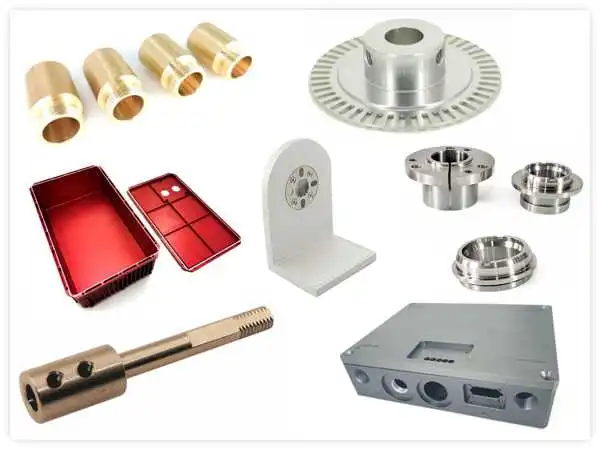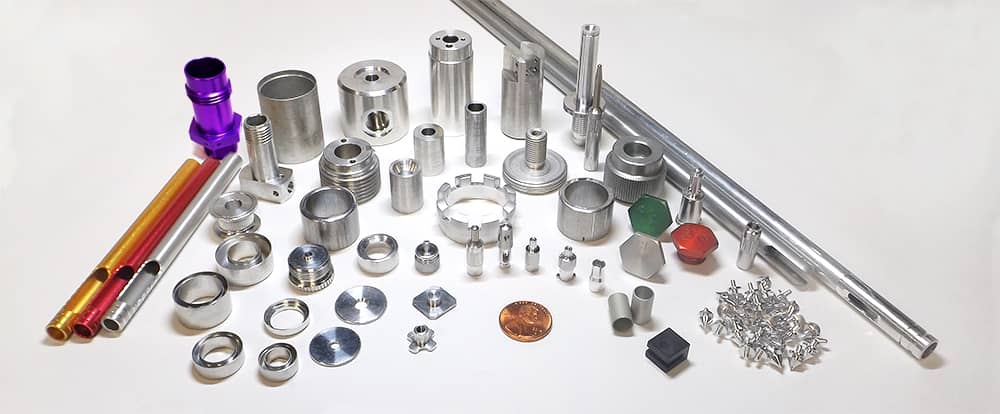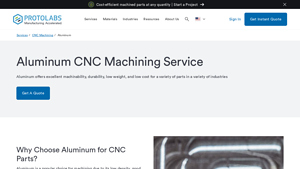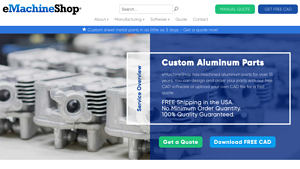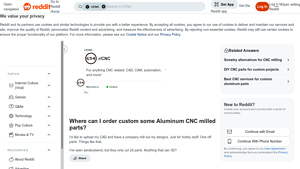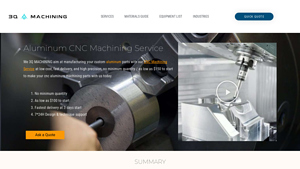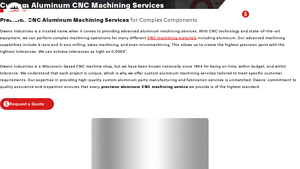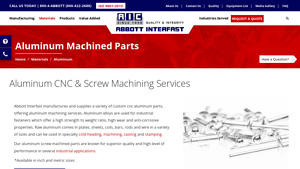Machining Aluminum Parts Guide: Type, Cost, Top List…
Introduction: Navigating the Global Market for machining aluminum parts
In an increasingly competitive landscape, sourcing high-quality machining aluminum parts can pose significant challenges for international B2B buyers. Factors such as varying material properties, complex manufacturing processes, and the need for cost efficiency can complicate procurement decisions, especially for businesses operating in regions like Africa, South America, the Middle East, and Europe. This guide serves as a comprehensive resource, addressing the diverse types of aluminum alloys, their applications across multiple industries—including aerospace, automotive, and electronics—and essential considerations for supplier vetting.
Understanding the nuances of aluminum machining is crucial for making informed purchasing decisions. From exploring different alloy grades like 6061-T651 and 7075-T651 to evaluating surface finishing options such as anodizing, this guide provides actionable insights that empower buyers to navigate the complexities of the global market. It also covers critical aspects such as cost factors and design for manufacturability, ensuring that stakeholders can optimize their sourcing strategies.
By leveraging the knowledge contained in this guide, B2B buyers can enhance their procurement processes, minimize risks, and secure reliable partnerships with manufacturers. This resource is designed to not only streamline your purchasing journey but also to foster informed decision-making that aligns with your business objectives in an ever-evolving market.
Understanding machining aluminum parts Types and Variations
| Type Name | Key Distinguishing Features | Primary B2B Applications | Brief Pros & Cons for Buyers |
|---|---|---|---|
| Aluminum 6061 | Versatile, good corrosion resistance, excellent weldability | Automotive, aerospace, general manufacturing | Pros: Cost-effective, easy to machine. Cons: Not the strongest alloy. |
| Aluminum 7075 | High strength and fatigue resistance, less corrosion resistant | Aerospace, military, high-stress applications | Pros: Superior strength-to-weight ratio. Cons: Higher cost and lower corrosion resistance. |
| Aluminum 2024 | Excellent fatigue resistance, poor weldability | Aircraft structures, military applications | Pros: High strength, good machinability. Cons: Requires surface treatment for corrosion. |
| Aluminum 5052 | Excellent corrosion resistance, good formability | Marine applications, fuel tanks, automotive | Pros: Very resistant to corrosion. Cons: Cannot be heat-treated. |
| Aluminum MIC-6 | Stress-free casting, high dimensional accuracy | Precision fixtures, jigs, and tooling | Pros: Ideal for high-speed machining, minimal distortion. Cons: Lower strength compared to other alloys. |
What Are the Characteristics of Aluminum 6061 Parts?
Aluminum 6061 is a general-purpose alloy known for its excellent machinability and weldability. It features a good balance of strength and corrosion resistance, making it suitable for a wide range of applications, including automotive components and structural parts in aerospace. Buyers should consider its cost-effectiveness and versatility, particularly for projects where weight is a concern. However, while it is widely used, it may not provide the highest strength compared to other aluminum alloys.
Why Choose Aluminum 7075 for High-Strength Applications?
Aluminum 7075 is recognized for its exceptional strength-to-weight ratio and fatigue resistance, making it a preferred choice in aerospace and military applications. This alloy is particularly effective in high-stress environments but has a trade-off in corrosion resistance. B2B buyers should weigh the benefits of its strength against the higher cost and the necessity for protective coatings in corrosive conditions, especially in applications exposed to harsh environments.
How Does Aluminum 2024 Stand Out in Machining?
Aluminum 2024 is renowned for its fatigue resistance, often used in aircraft structures and military applications where durability is critical. While it offers excellent machinability, its weldability is limited, which may necessitate alternative joining methods. Buyers should consider the need for surface treatments to enhance corrosion resistance in demanding environments, balancing the alloy’s high strength with its specific application requirements.
In What Situations is Aluminum 5052 Preferred?
Aluminum 5052 is notable for its outstanding corrosion resistance and good formability, making it ideal for marine applications, fuel tanks, and automotive parts. This alloy cannot be heat-treated, which limits its use in high-strength applications but simplifies manufacturing processes. B2B buyers should focus on its cost-effectiveness and suitability for environments where corrosion is a concern, while also acknowledging its limitations in terms of strength.
What Makes Aluminum MIC-6 Ideal for Precision Components?
Aluminum MIC-6 is a cast alloy designed for applications requiring high dimensional accuracy and minimal internal stresses. Its properties allow for high-speed machining with reduced distortion, making it ideal for precision fixtures and tooling. Buyers should consider its suitability for high-accuracy applications, recognizing that while it excels in precision, it may not provide the same strength as other aluminum alloys, potentially limiting its use in structural applications.
Key Industrial Applications of machining aluminum parts
| Industry/Sector | Specific Application of machining aluminum parts | Value/Benefit for the Business | Key Sourcing Considerations for this Application |
|---|---|---|---|
| Aerospace | Lightweight aircraft components (brackets, housings) | Enhanced fuel efficiency and performance | Certification standards, precision machining, lead times |
| Automotive | Engine components and chassis parts | Improved strength-to-weight ratio for better efficiency | Alloy selection, corrosion resistance, custom specifications |
| Industrial Equipment | Fixtures and tooling for manufacturing processes | Increased operational efficiency and reduced downtime | Custom designs, material certifications, delivery timelines |
| Consumer Electronics | Enclosures and heat sinks for devices | Enhanced durability and thermal management | Aesthetic finishes, precision tolerances, volume pricing |
| Medical Devices | Surgical instruments and equipment housings | High strength and biocompatibility | Regulatory compliance, material traceability, lead times |
How is Machining Aluminum Parts Utilized in Aerospace Applications?
In the aerospace sector, machining aluminum parts is critical for producing lightweight components like brackets and housings that contribute to overall aircraft efficiency. These components must adhere to strict safety and performance standards while minimizing weight to enhance fuel efficiency. International buyers, especially from regions with burgeoning aerospace markets, should ensure that their suppliers can meet certification requirements and provide precision machining capabilities to maintain the integrity of these components.
What Role Does Aluminum Machining Play in Automotive Manufacturing?
Aluminum machining in the automotive industry focuses on creating engine components and chassis parts that leverage aluminum’s superior strength-to-weight ratio. This translates to vehicles that are lighter, more fuel-efficient, and compliant with stringent emissions regulations. For B2B buyers, selecting the right aluminum alloy is crucial, as it can significantly impact performance and durability. Additionally, sourcing partners should have the ability to customize specifications and provide corrosion-resistant treatments to ensure longevity under harsh conditions.
Why is Machining Aluminum Important for Industrial Equipment?
In industrial manufacturing, aluminum machining is essential for producing fixtures and tooling that enhance operational efficiency. These components are designed to withstand wear and tear while maintaining precision, thus reducing downtime. When sourcing these parts, businesses should focus on suppliers that can offer custom designs tailored to specific manufacturing processes, along with reliable delivery timelines to minimize disruptions in production.
How Does Machining Aluminum Enhance Consumer Electronics?
Machining aluminum parts for consumer electronics involves creating durable enclosures and heat sinks that not only protect sensitive components but also improve thermal management. The lightweight nature of aluminum allows for sleek designs without compromising on strength. B2B buyers in this sector should prioritize suppliers who can deliver high-quality finishes and precision tolerances, as these factors significantly influence the aesthetic and functional performance of the final products.
What is the Significance of Aluminum Machining in Medical Device Manufacturing?
In the medical sector, machining aluminum parts is vital for manufacturing surgical instruments and equipment housings that require high strength and biocompatibility. These components must meet stringent regulatory standards and be produced with material traceability to ensure safety. For international buyers, it is essential to partner with suppliers who understand these regulations and can provide timely delivery of compliant products, thus ensuring uninterrupted access to critical medical technologies.
3 Common User Pain Points for ‘machining aluminum parts’ & Their Solutions
Scenario 1: Difficulty in Selecting the Right Aluminum Alloy
The Problem: Many B2B buyers struggle with the selection of the appropriate aluminum alloy for their specific applications. With a multitude of aluminum grades available—each with unique properties like strength, corrosion resistance, and machinability—it can be overwhelming. For instance, a buyer in the aerospace sector might need an alloy that can withstand high stress and fatigue, such as 7075-T651, but they may lack the technical background to make an informed decision. This can lead to costly mistakes, such as choosing an alloy that is either too weak or overly expensive for the intended use.
The Solution: To address this issue, buyers should engage in a thorough material selection process. Begin by clearly defining the application requirements, including load-bearing capacity, environmental exposure, and any specific regulatory standards that must be met. Once you have this information, consult with suppliers who specialize in aluminum alloys. Ask for detailed specifications and performance data on various grades to compare them against your requirements. Additionally, consider utilizing digital tools or software that can help simulate material performance under specific conditions. This proactive approach not only saves time and resources but ensures that you are using the most suitable aluminum alloy for your project.
Scenario 2: Challenges in Machining Precision Parts
The Problem: Precision is crucial in industries like aerospace and automotive, where even minor deviations can lead to significant operational failures. Buyers often face challenges in machining aluminum parts that meet tight tolerances. Issues such as tool wear, incorrect feed rates, or suboptimal machining parameters can result in parts that do not fit or function correctly, leading to delays and increased costs. This can be particularly frustrating when dealing with complex geometries or intricate designs.
The Solution: To overcome machining challenges, it is essential to collaborate closely with your machining partner. Start by sharing detailed design specifications, including tolerances and critical dimensions. Work with them to determine the best machining techniques and parameters for your specific parts. For instance, using high-quality cutting tools specifically designed for aluminum can greatly enhance precision and surface finish. Furthermore, consider implementing a quality assurance program that includes in-process inspections to catch deviations early. This not only ensures adherence to specifications but also fosters a collaborative relationship with your machining provider, enhancing overall project success.
Scenario 3: Post-Machining Surface Treatment Issues
The Problem: After machining, the surface finish of aluminum parts can be a significant concern, especially in industries where aesthetics and corrosion resistance are paramount. Buyers may find that standard machining processes do not yield the desired surface quality, leading to potential issues with adhesion in subsequent finishing processes such as anodizing or painting. This can result in additional costs and delays as parts may require rework or even complete remanufacturing.
The Solution: To ensure optimal surface quality, it is advisable to incorporate surface treatment considerations into the initial design phase. Communicate with your machining partner about the desired finish and any surface treatments that will be applied afterward. Specify the required surface roughness and ensure that the machining processes used (e.g., milling, turning) are compatible with these specifications. Additionally, consider using surface finishing techniques such as bead blasting or polishing before applying anodization, as these methods can enhance adhesion and improve the overall appearance. Engaging in this proactive approach will not only streamline your production process but also enhance the longevity and aesthetic appeal of the final product.
Strategic Material Selection Guide for machining aluminum parts
What Are the Key Properties of Common Aluminum Alloys for Machining?
When selecting aluminum alloys for machining, it is crucial to understand their properties, advantages, and limitations. Here, we analyze four common aluminum alloys: 6061, 7075, 2024, and 5052, each with distinct characteristics that affect their suitability for various applications.
How Does Aluminum 6061 Perform in Machining Applications?
Aluminum 6061 is a versatile alloy known for its excellent machinability and weldability. It has a moderate strength-to-weight ratio and good corrosion resistance, making it suitable for a wide range of applications, including automotive and aerospace components. It typically withstands temperatures up to 150°C and exhibits good performance in structural applications.
Pros:
– Excellent corrosion resistance
– Good machinability and weldability
– Moderate cost
Cons:
– Lower strength compared to other alloys like 7075
– Not ideal for high-stress applications
Impact on Application:
6061 is widely used for parts that require good mechanical properties without extreme strength demands. It is compatible with various media, including water and mild chemicals.
Considerations for International Buyers:
Buyers from regions like Europe and the Middle East should ensure compliance with standards such as ASTM B221 and EN 573. The alloy is widely available, but variations in specifications may exist.
What Are the Advantages of Using Aluminum 7075?
Aluminum 7075 is one of the strongest aluminum alloys available, often used in aerospace applications where high strength is paramount. It offers excellent fatigue resistance and can withstand high-stress conditions, making it ideal for components like aircraft fittings and gears.
Pros:
– High strength and fatigue resistance
– Suitable for high-stress applications
Cons:
– Poor weldability
– Higher cost compared to other alloys
Impact on Application:
7075 is suitable for applications exposed to cyclic loading, such as aircraft structures. However, its lower corrosion resistance necessitates surface treatments in harsh environments.
Considerations for International Buyers:
Compliance with aerospace standards like MIL-A-8625 is crucial. Buyers in regions like Saudi Arabia and South America should verify the alloy’s availability and specifications.
Why Choose Aluminum 2024 for Specialized Applications?
Aluminum 2024 is known for its high strength and fatigue resistance, making it a preferred choice for aerospace applications. However, it exhibits poor corrosion resistance and requires surface treatments for longevity. This alloy is typically used for aircraft fittings and high-stress components.
Pros:
– Excellent fatigue resistance
– High strength
Cons:
– Poor corrosion resistance
– Limited weldability
Impact on Application:
2024 is ideal for applications requiring high strength but may not be suitable for environments with high corrosion potential unless adequately treated.
Considerations for International Buyers:
Adherence to standards such as ASTM B209 and AMS 4037 is essential for compliance. Buyers should also consider local availability and any import regulations.
What Makes Aluminum 5052 a Good Option for Corrosion Resistance?
Aluminum 5052 is primarily alloyed with magnesium, providing excellent corrosion resistance, particularly in marine environments. It is commonly used in fuel tanks and marine applications due to its durability and formability.
Pros:
– Excellent corrosion resistance
– Good formability
Cons:
– Cannot be heat-treated
– Lower strength compared to other alloys
Impact on Application:
5052 is ideal for applications exposed to corrosive media, such as seawater. Its formability allows for complex shapes, but it may not be suitable for high-stress applications.
Considerations for International Buyers:
Buyers should ensure compliance with standards like ASTM B209 and consider the alloy’s availability in their region, especially in coastal areas where corrosion resistance is critical.
Summary Table of Aluminum Alloys for Machining
| Material | Typical Use Case for machining aluminum parts | Key Advantage | Key Disadvantage/Limitation | Relative Cost (Low/Med/High) |
|---|---|---|---|---|
| Aluminum 6061 | Automotive and aerospace components | Excellent corrosion resistance | Lower strength compared to others | Medium |
| Aluminum 7075 | Aerospace structures and high-stress parts | High strength and fatigue resistance | Poor weldability | High |
| Aluminum 2024 | Aircraft fittings and components | Excellent fatigue resistance | Poor corrosion resistance | High |
| Aluminum 5052 | Marine applications and fuel tanks | Excellent corrosion resistance | Cannot be heat-treated | Medium |
This guide equips international B2B buyers with critical insights into aluminum alloys, enabling informed decisions based on their specific application needs and regional compliance requirements.
In-depth Look: Manufacturing Processes and Quality Assurance for machining aluminum parts
What Are the Main Stages of the Manufacturing Process for Machining Aluminum Parts?
The manufacturing process for machining aluminum parts involves several key stages that ensure precision and quality. Each stage plays a critical role in transforming raw aluminum into high-quality components ready for various applications.
Material Preparation: How Is Aluminum Readied for Machining?
Material preparation begins with selecting the appropriate aluminum alloy, such as 6061, 7075, or 2024, based on the intended application. These alloys exhibit varying mechanical properties, and choosing the right one is crucial for performance. Following selection, the aluminum is cut into manageable sizes, often in the form of sheets or bars. This stage may also involve heat treatment to enhance the material’s machinability and strength.
What Techniques Are Used in Forming Aluminum Parts?
The forming stage typically employs CNC (Computer Numerical Control) machining, which allows for high precision and repeatability. CNC machining encompasses various techniques, including milling, turning, and drilling. Advanced software programs guide the CNC machines, ensuring that the desired specifications are met consistently.
In addition to CNC machining, secondary processes such as bending, extrusion, and die-casting may be employed, depending on the complexity of the parts. These techniques allow for the creation of intricate geometries while maintaining the integrity of the aluminum.
How Is Assembly Conducted in Aluminum Machining?
Once the individual components are machined, they may require assembly. This stage can involve welding, riveting, or fastening, depending on the application and design requirements. It is crucial to ensure that the assembly process does not compromise the mechanical properties of the aluminum. For instance, when welding aluminum, preheating may be necessary to prevent warping or cracking.
What Are the Finishing Processes Applied to Machined Aluminum Parts?
Finishing processes enhance the appearance and performance of machined aluminum parts. Anodizing is one of the most common finishing techniques, providing corrosion resistance and aesthetic appeal. Depending on the required durability, different anodizing types—such as Type I, II, and III—can be applied.
Other finishing techniques may include powder coating, painting, or surface polishing. Each method serves to protect the aluminum from environmental factors while also meeting the aesthetic preferences of end-users.
What Quality Assurance Measures Are Essential for Machining Aluminum Parts?
Quality assurance (QA) is a critical aspect of the manufacturing process, ensuring that the final products meet international and industry-specific standards. Adhering to these standards is vital for B2B buyers, especially those operating in regions with stringent regulations.
Which International Standards Should B2B Buyers Be Aware Of?
ISO 9001 is the most recognized international standard for quality management systems (QMS). Compliance with ISO 9001 ensures that the manufacturer has established processes to consistently provide products that meet customer and regulatory requirements. Additionally, industry-specific certifications, such as CE marking for European markets or API standards for oil and gas applications, may be essential depending on the product’s intended use.
What Are the Key Quality Control Checkpoints in the Manufacturing Process?
Quality control (QC) involves several checkpoints throughout the manufacturing process:
-
Incoming Quality Control (IQC): This initial stage involves inspecting raw materials upon arrival. Manufacturers verify that the aluminum meets specified standards before proceeding with production.
-
In-Process Quality Control (IPQC): During machining, real-time monitoring is essential. Operators use measurement tools such as calipers and gauges to ensure that tolerances are maintained throughout the process.
-
Final Quality Control (FQC): Once the machining and finishing processes are complete, a thorough inspection is conducted. This includes dimensional checks, visual inspections, and functional testing to ensure the parts perform as intended.
How Can B2B Buyers Verify Supplier Quality Control?
Verification of a supplier’s quality control processes is crucial for B2B buyers to ensure reliability and consistency. Here are some actionable steps:
-
Conduct Supplier Audits: Regular audits can provide insights into a manufacturer’s QA processes. During an audit, B2B buyers should assess the supplier’s adherence to international standards, as well as their internal QC procedures.
-
Request Quality Reports: Suppliers should be able to provide documentation of their QC processes, including inspection reports and compliance certificates. These documents should detail the methods used and results obtained from various quality checks.
-
Utilize Third-Party Inspections: Engaging third-party inspection services can offer an unbiased assessment of the supplier’s quality practices. These services can conduct random sampling and testing to verify compliance with agreed-upon specifications.
What Are the Specific QC and Certification Nuances for International B2B Buyers?
International buyers face unique challenges concerning quality control and certification. For instance, variations in regulatory requirements across regions—such as those found in Africa, South America, the Middle East, and Europe—can complicate the procurement process.
B2B buyers should:
-
Understand Regional Regulations: Familiarizing themselves with local standards and regulations can help buyers ensure compliance when importing products.
-
Build Relationships with Local Authorities: Establishing connections with local regulatory bodies can facilitate smoother imports and compliance verification.
-
Consider Cultural and Language Differences: Effective communication with suppliers from different regions can mitigate misunderstandings related to quality expectations and specifications.
By understanding the manufacturing processes and quality assurance measures involved in machining aluminum parts, B2B buyers can make informed decisions that align with their operational needs and quality standards.
Practical Sourcing Guide: A Step-by-Step Checklist for ‘machining aluminum parts’
Introduction
This practical sourcing guide serves as a step-by-step checklist for B2B buyers looking to procure machined aluminum parts. Aluminum is favored for its excellent machinability, strength-to-weight ratio, and versatility across various industries. Following this checklist will ensure that you make informed decisions when sourcing aluminum parts, ultimately leading to successful partnerships and high-quality products.
Step 1: Define Your Technical Specifications
Clearly outline the technical specifications of the aluminum parts you require. This includes dimensions, tolerances, and any specific performance characteristics. Defining these parameters upfront will help streamline the sourcing process and ensure that potential suppliers can meet your exact needs.
- Considerations: Include material grade (e.g., 6061, 7075) and any necessary surface finishes like anodizing or plating.
Step 2: Identify Your Application Requirements
Understanding the specific application for your aluminum parts is crucial. Different industries, such as aerospace, automotive, or electronics, have unique standards and performance requirements. Identifying these will help you select the appropriate aluminum alloy and machining process.
- Key Questions: What is the weight capacity needed? Will the parts be exposed to corrosive environments?
Step 3: Evaluate Potential Suppliers
Before committing to a supplier, conduct thorough evaluations to ensure their capabilities align with your requirements. Request company profiles, case studies, and references from clients in similar industries or regions. This step mitigates risks associated with quality and reliability.
- Verification: Check for certifications (e.g., ISO 9001) that indicate a commitment to quality standards.
Step 4: Request Quotes and Compare Pricing
Obtain detailed quotes from multiple suppliers. Ensure that the quotes include not just pricing but also lead times, minimum order quantities, and payment terms. Comparing these elements will provide a clearer picture of the overall value each supplier offers.
- Cost Factors: Be aware of additional costs for surface treatments or custom designs that may not be included in the initial quote.
Step 5: Assess Production Capabilities
Investigate the production capabilities of your shortlisted suppliers. This includes their machinery, technology, and workforce expertise. A supplier with advanced CNC machining capabilities can often provide better precision and faster turnaround times.
- Questions to Ask: What types of CNC machines do they use? How do they ensure quality control during production?
Step 6: Verify Quality Assurance Processes
Quality assurance is paramount in the machining process. Inquire about the supplier’s quality control measures and testing protocols. A robust quality assurance process will minimize defects and ensure that the final products meet your specifications.
- Look For: Documentation of quality checks, inspection reports, and any relevant testing certifications.
Step 7: Establish Communication and Support Channels
Effective communication is key to a successful supplier relationship. Ensure that your chosen supplier has a dedicated point of contact and is responsive to inquiries. Establishing clear communication channels will facilitate problem-solving and updates throughout the production process.
- Best Practices: Schedule regular check-ins to discuss project status and address any concerns proactively.
By following this checklist, you will be better equipped to source high-quality machined aluminum parts that meet your specifications and support your business objectives.
Comprehensive Cost and Pricing Analysis for machining aluminum parts Sourcing
What Are the Key Cost Components for Machining Aluminum Parts?
When sourcing aluminum parts, understanding the cost structure is crucial for international B2B buyers. The primary cost components include:
-
Materials: The choice of aluminum alloy significantly influences cost. Common alloys like 6061 and 7075 vary in price due to differences in strength, machinability, and availability. Market fluctuations can also affect material costs.
-
Labor: Skilled labor is essential for CNC machining. Labor costs can vary by region, with countries in Europe typically having higher labor rates compared to those in Africa or South America. The complexity of the machining process will also impact labor costs.
-
Manufacturing Overhead: This encompasses operational costs such as utilities, equipment maintenance, and facility expenses. Overhead is often distributed across production volume, making it crucial to consider batch sizes when analyzing costs.
-
Tooling: The initial investment in tooling can be significant, especially for custom parts. Tooling costs are amortized over the production run, so higher volumes can lead to lower per-unit tooling costs.
-
Quality Control (QC): Ensuring high-quality output involves inspection and testing processes, which can add to costs. Certifications and compliance with industry standards (such as ISO) may also incur additional expenses.
-
Logistics: Transportation and shipping play a vital role, especially for international buyers. Costs can vary based on distance, shipping method, and whether Incoterms like FOB or CIF are used.
-
Margin: Suppliers typically apply a markup on costs to ensure profitability. This margin can vary based on the supplier’s market position, demand, and competition.
How Do Price Influencers Affect the Cost of Machined Aluminum Parts?
Several factors influence pricing beyond the basic cost components:
-
Volume/MOQ: Minimum order quantities (MOQ) can impact pricing. Larger orders generally result in lower per-unit costs due to economies of scale, while smaller orders might incur higher rates.
-
Specifications and Customization: Custom features can increase complexity and lead to higher costs. Standardized designs are usually more cost-effective, so buyers should consider design simplifications.
-
Material Selection: The choice of aluminum alloy affects not only the price but also the part’s performance. Higher-strength alloys may be more expensive but could lead to lower total costs through enhanced durability and reduced weight.
-
Quality and Certifications: Parts requiring specific certifications or higher tolerances will incur additional costs. Buyers should weigh the benefits of these requirements against their project needs.
-
Supplier Factors: The reputation and reliability of suppliers can influence pricing. Established suppliers might charge a premium for their proven quality and service.
-
Incoterms: The agreed terms of delivery can affect overall costs. Understanding whether costs include shipping, insurance, and duties is essential for accurate budgeting.
What Tips Can Help Buyers Optimize Costs When Sourcing Aluminum Parts?
To achieve cost efficiency when sourcing aluminum parts, consider the following strategies:
-
Negotiate Wisely: Engage suppliers in discussions about pricing, especially for large orders. Leverage your position as a repeat buyer to negotiate better terms.
-
Focus on Total Cost of Ownership (TCO): Evaluate not just the upfront costs but also long-term factors such as maintenance, durability, and performance. An initially higher-priced part might save money over its lifecycle.
-
Be Aware of Pricing Nuances: International buyers should consider currency fluctuations, import duties, and tariffs that may affect the final cost. Understanding local market conditions can provide leverage in negotiations.
-
Streamline Designs: Optimize designs for manufacturing to minimize complex features that could increase machining time and costs. This approach can lead to significant savings.
-
Research and Compare Suppliers: Investigate multiple suppliers to find the best balance of cost, quality, and service. Request quotes from several providers to ensure competitive pricing.
Disclaimer on Indicative Prices
Prices for machining aluminum parts can vary widely based on numerous factors, including market conditions, supplier capabilities, and specific project requirements. Buyers should obtain detailed quotes based on their unique specifications to ensure accurate cost projections.
Alternatives Analysis: Comparing machining aluminum parts With Other Solutions
When exploring the manufacturing landscape for aluminum components, it is essential to consider various methods and technologies that can achieve similar objectives. Each method comes with its unique benefits and drawbacks, which can significantly influence decision-making for international B2B buyers. Below, we compare machining aluminum parts with two viable alternatives: 3D printing and injection molding.
| Comparison Aspect | Machining Aluminum Parts | 3D Printing | Injection Molding |
|---|---|---|---|
| Performance | High precision and finish; excellent strength-to-weight ratio. | Good for complex geometries; limited by material properties. | High volume production with consistent quality. |
| Cost | Moderate initial cost; cost-effective for small to medium runs. | Higher costs for materials and machinery; economical for small batches. | High initial setup cost; cost-effective for large quantities. |
| Ease of Implementation | Requires skilled labor and specialized equipment; straightforward for standard parts. | Simple for complex designs but requires expertise in design software. | Complex setup; requires molds which can be time-consuming to produce. |
| Maintenance | Regular maintenance needed for CNC machines; lower wear. | Minimal; mainly software updates and printer maintenance. | High maintenance for molds; wear and tear can lead to defects. |
| Best Use Case | Aerospace, automotive, and custom parts needing high precision. | Prototyping and low-volume production of intricate designs. | Mass production of standardized parts with high repeatability. |
What Are the Pros and Cons of 3D Printing as an Alternative to Machining Aluminum Parts?
3D printing, or additive manufacturing, offers a compelling alternative, particularly for prototypes or low-volume production runs. Its key advantage is the ability to create complex geometries that are difficult or impossible to achieve with traditional machining. Moreover, it allows for rapid iterations in design without the need for expensive tooling or molds. However, the material properties of 3D printed parts, especially in terms of strength and durability, may not match those of machined aluminum. Additionally, the cost of materials can be higher, and the process might not be suitable for high-volume production.
How Does Injection Molding Compare to Machining Aluminum Parts?
Injection molding is another prevalent manufacturing method, especially for producing large volumes of identical parts. It is highly efficient and can yield consistent quality across mass production runs. While the initial costs associated with creating molds are significant, the per-unit cost decreases substantially with higher volumes. This makes injection molding an excellent choice for high-demand products. However, it lacks the flexibility of machining when it comes to design changes and is not ideal for small batches or complex geometries where aluminum machining excels. The setup time and costs can also be a barrier for projects requiring rapid turnaround.
How Can B2B Buyers Choose the Right Solution for Their Needs?
For B2B buyers, selecting the right manufacturing solution hinges on several factors, including project scale, budget, and design complexity. Machining aluminum parts is typically the go-to for high precision and strength, making it ideal for industries like aerospace and automotive. In contrast, 3D printing serves best when rapid prototyping and design flexibility are paramount, while injection molding is the ideal choice for high-volume production where cost efficiency is critical. Analyzing these aspects in alignment with specific project requirements will empower buyers to make informed decisions that align with their operational goals and market demands.
Essential Technical Properties and Trade Terminology for machining aluminum parts
What Are the Key Technical Properties for Machining Aluminum Parts?
When sourcing aluminum parts for machining, understanding the essential technical specifications is crucial for ensuring quality and performance. Here are some critical properties that B2B buyers should consider:
-
Material Grade
Aluminum alloys are classified by a four-digit number, indicating their primary alloying elements. Common grades include 6061, known for its excellent corrosion resistance and machinability, and 7075, recognized for its high strength. Selecting the right grade impacts the part’s durability, weight, and functionality, making it essential for applications in industries like aerospace and automotive. -
Tensile Strength
This property measures the maximum stress that a material can withstand while being stretched or pulled before failing. For example, 6061-T651 has a tensile strength of approximately 45 ksi, while 7075-T651 can reach up to 78 ksi. High tensile strength is vital for components that will experience heavy loads or stress, such as aircraft fittings and automotive parts. -
Elongation
Elongation indicates how much a material can deform before it breaks, expressed as a percentage. It is a key factor in determining the material’s ductility. For instance, 2024-T3 has an elongation of about 19%, making it suitable for applications requiring some flexibility. Understanding elongation helps in assessing how well a part will perform in dynamic environments. -
Hardness
Hardness refers to a material’s resistance to deformation, which is crucial for parts subject to wear and tear. Measured on scales like Rockwell or Brinell, aluminum alloys like 7075 can achieve hardness values of up to 150 HRB. This property is particularly important for components that must maintain their shape and integrity under stress. -
Machinability
This property assesses how easily a material can be machined to achieve the desired shape and finish. Aluminum alloys such as 6061 and 5052 are known for their excellent machinability, which can lead to lower production costs and reduced lead times. For B2B buyers, understanding machinability can facilitate smoother manufacturing processes and better end-product quality. -
Corrosion Resistance
Aluminum is naturally resistant to corrosion, but this property can vary significantly among different alloys. For instance, 5052 exhibits high resistance due to its magnesium content, while 2024 may require additional surface treatments. Selecting materials with appropriate corrosion resistance is vital for applications in harsh environments, such as marine or chemical processing industries.
What Are Common Trade Terms in Aluminum Machining?
Familiarity with industry terminology can significantly enhance communication and negotiations between buyers and suppliers. Here are some common trade terms relevant to aluminum machining:
-
OEM (Original Equipment Manufacturer)
This term refers to companies that produce parts or equipment that are used in another company’s end products. Understanding OEM relationships can help buyers identify reliable suppliers for custom parts that meet specific design requirements. -
MOQ (Minimum Order Quantity)
MOQ indicates the smallest number of units a supplier is willing to produce or sell. Knowing the MOQ is essential for budget planning and can affect inventory levels, especially for smaller businesses looking to source aluminum parts without overcommitting financially. -
RFQ (Request for Quotation)
An RFQ is a formal document sent to suppliers requesting pricing and availability for specific parts or services. For B2B buyers, crafting an effective RFQ can streamline the procurement process and ensure that they receive competitive bids tailored to their project needs. -
Incoterms (International Commercial Terms)
These are a set of predefined international trade terms that clarify the responsibilities of buyers and sellers in international transactions. Understanding Incoterms is crucial for determining shipping costs, risk management, and delivery schedules, especially when sourcing from global suppliers. -
CNC (Computer Numerical Control)
CNC refers to automated machining processes controlled by computer programs. This technology enhances precision and repeatability in producing aluminum parts, making it a preferred choice for high-volume manufacturing. Recognizing the benefits of CNC can help buyers choose suppliers that utilize advanced machining technologies. -
Anodizing
Anodizing is an electrochemical process that enhances the corrosion resistance and aesthetic appeal of aluminum parts. Understanding the types of anodizing (e.g., Type I, II, III) can help buyers select the right finishing options for their specific applications, ensuring durability and visual quality.
Incorporating these technical properties and trade terms into your procurement strategy can lead to more informed decisions, ensuring that the aluminum parts you source meet both performance and budgetary requirements.
Navigating Market Dynamics and Sourcing Trends in the machining aluminum parts Sector
What Are the Key Market Drivers and Trends in Machining Aluminum Parts?
The machining aluminum parts sector is currently driven by several global factors, particularly as industries seek lightweight, high-strength materials. The aerospace, automotive, and electronics industries are increasingly adopting aluminum due to its excellent strength-to-weight ratio, durability, and cost-effectiveness. Emerging technologies, such as advanced CNC machining and automation, are enhancing production efficiencies, thereby reducing lead times and costs for international buyers.
In regions like Africa and South America, there’s a growing demand for locally sourced aluminum components, influenced by the push for regional manufacturing capabilities. Meanwhile, buyers in the Middle East and Europe are leveraging advanced sourcing platforms to connect with global suppliers, ensuring they obtain high-quality components that meet specific industry standards. The trend towards customization is also significant; businesses are looking for suppliers who can provide tailored solutions to meet their unique design requirements.
Furthermore, the COVID-19 pandemic has accelerated digital transformation in procurement processes, leading to increased reliance on online quoting engines and virtual collaboration tools. This shift is particularly relevant for international B2B buyers, who are now able to engage with suppliers across borders more seamlessly than ever before.
How Important Is Sustainability and Ethical Sourcing in the Aluminum Machining Industry?
Sustainability and ethical sourcing are becoming paramount in the machining aluminum parts sector. As environmental concerns rise globally, buyers are increasingly prioritizing suppliers who demonstrate a commitment to reducing their environmental footprint. This includes using recycled aluminum, which not only conserves natural resources but also reduces energy consumption during production.
Ethical supply chains are essential, especially in emerging markets where labor practices can vary significantly. Buyers are encouraged to seek partners who adhere to international labor standards and possess certifications that demonstrate their commitment to ethical practices. Certifications such as ISO 14001 for environmental management and ISO 45001 for occupational health and safety are valuable indicators of a supplier’s commitment to sustainability.
Moreover, the use of ‘green’ materials is gaining traction. Aluminum alloys that are easy to recycle and processes that minimize waste are becoming the norm. This shift not only satisfies regulatory requirements but also appeals to environmentally conscious consumers, enhancing brand reputation and competitive advantage.
What Is the Historical Context of Machining Aluminum Parts in B2B Markets?
The evolution of machining aluminum parts can be traced back to the early 20th century when aluminum began to gain popularity as a lightweight alternative to steel. The aerospace industry was one of the first to adopt aluminum for its superior strength-to-weight ratio, particularly during World War II. As manufacturing technologies advanced, CNC machining emerged, revolutionizing the production of complex aluminum components with high precision.
In recent decades, the introduction of advanced alloys and machining techniques has further expanded the applications of aluminum in various sectors, including automotive and electronics. Today, the integration of digital technologies and automation in machining processes is reshaping the landscape, making it easier for international B2B buyers to access high-quality aluminum parts while maintaining cost-effectiveness and efficiency.
In conclusion, understanding market dynamics, embracing sustainability, and recognizing the historical context are essential for B2B buyers navigating the machining aluminum parts sector. These insights not only enhance procurement strategies but also align with broader industry trends towards innovation and responsibility.
Frequently Asked Questions (FAQs) for B2B Buyers of machining aluminum parts
-
How do I choose the right aluminum alloy for my project?
Choosing the right aluminum alloy depends on the specific requirements of your project, such as strength, weight, corrosion resistance, and machinability. Common alloys like 6061-T651 are versatile and offer good corrosion resistance, while 7075-T651 is ideal for high-strength applications. Evaluate the mechanical properties and environmental conditions your parts will face to determine the most suitable alloy. Consulting with your supplier can provide insights based on their experience and capabilities. -
What are the typical lead times for machining aluminum parts?
Lead times for machining aluminum parts can vary significantly based on factors such as complexity, volume, and supplier capacity. Generally, you can expect lead times ranging from a few days for simple components to several weeks for more complex parts or larger quantities. It’s advisable to communicate your timeline clearly with your supplier to ensure they can meet your deadlines and consider any potential delays in shipping or customs clearance. -
What should I consider when vetting an aluminum machining supplier?
When vetting a supplier for aluminum machining, assess their experience in your industry and their technical capabilities. Look for certifications such as ISO 9001, which indicates a commitment to quality management. Request references or case studies to understand their past performance. Additionally, consider their communication responsiveness and willingness to collaborate on design improvements, as these factors can significantly impact the success of your project. -
What are the minimum order quantities (MOQs) for aluminum machining?
Minimum order quantities (MOQs) for aluminum machining can vary by supplier and project type. Some suppliers may have low MOQs for prototype runs, while others may require higher quantities for cost-effectiveness. It’s essential to discuss your needs with potential suppliers to find a partner that can accommodate your order size without compromising on quality or lead time. -
What are the payment terms I should expect for international aluminum machining orders?
Payment terms for international orders can vary widely among suppliers. Common arrangements include upfront deposits (typically 30-50%) with the balance due upon delivery or acceptance of the parts. Some suppliers may offer net terms (e.g., net 30 or net 60 days) based on your creditworthiness. Always clarify payment terms upfront and ensure they are included in your purchase agreement to avoid misunderstandings later. -
How can I ensure quality assurance (QA) in aluminum machining?
To ensure quality assurance in aluminum machining, establish clear specifications and standards at the outset of your project. Request documentation such as material certifications, dimensional reports, and inspection results from your supplier. Consider implementing a third-party inspection or audit process, especially for critical components. Building a strong relationship with your supplier will also facilitate open communication regarding quality concerns and improvements. -
What logistics considerations should I keep in mind for shipping aluminum parts internationally?
When shipping aluminum parts internationally, consider factors such as shipping method, customs regulations, and duties. Air freight is faster but more expensive, while sea freight is cost-effective for larger orders but takes longer. Ensure your supplier is familiar with international shipping processes and can provide necessary documentation. Additionally, factor in potential customs delays and ensure compliance with import/export regulations in your destination country. -
Can I customize the design of my aluminum parts?
Yes, most reputable aluminum machining suppliers offer customization options for your parts. You can specify dimensions, tolerances, surface finishes, and other features based on your project requirements. It’s crucial to provide detailed drawings or CAD files to convey your design accurately. Collaborating with your supplier during the design phase can also yield suggestions for manufacturability improvements, which can enhance both performance and cost-effectiveness.
Important Disclaimer & Terms of Use
⚠️ Important Disclaimer
The information provided in this guide, including content regarding manufacturers, technical specifications, and market analysis, is for informational and educational purposes only. It does not constitute professional procurement advice, financial advice, or legal advice.
While we have made every effort to ensure the accuracy and timeliness of the information, we are not responsible for any errors, omissions, or outdated information. Market conditions, company details, and technical standards are subject to change.
B2B buyers must conduct their own independent and thorough due diligence before making any purchasing decisions. This includes contacting suppliers directly, verifying certifications, requesting samples, and seeking professional consultation. The risk of relying on any information in this guide is borne solely by the reader.
Top 6 Machining Aluminum Parts Manufacturers & Suppliers List
1. Protolabs – Aluminum CNC Machining Service
Domain: protolabs.com
Registered: 2006 (19 years)
Introduction: Aluminum CNC Machining Service offers cost-efficient machined parts at any quantity. Key benefits of aluminum include excellent machinability, high strength and hardness, heat tolerance, corrosion resistance, electrical conductivity, overall versatility, and low cost. Common aluminum alloys used are 6061-T651, 7075-T651, and 2024-T351, each providing a balance of strength, machinability, and cost….
2. eMachineShop – Custom CNC Aluminum Parts
Domain: emachineshop.com
Registered: 1999 (26 years)
Introduction: Custom CNC Aluminum Parts Machining Service Overview: eMachineShop has over 15 years of experience in machining aluminum parts. Customers can design and order parts using free CAD software or upload their own CAD files for a fast quote. Key features include: FREE Shipping in the USA, No Minimum Order Quantity, and 100% Quality Guaranteed. Aluminum properties include excellent corrosion and chemica…
3. Reddit – Custom Aluminum CNC Parts
Domain: reddit.com
Registered: 2005 (20 years)
Introduction: Custom aluminum CNC milled parts, one-off designs, CAD file upload, hobbyist applications.
4. 3Q Machining – Custom Aluminum CNC Services
Domain: 3qmachining.com
Registered: 2020 (5 years)
Introduction: Aluminum CNC Machining Service for custom aluminum parts. Key features include:
– No minimum quantity required
– Starting price as low as $100
– Fastest delivery in 3 days
– Design and technique support available
– Tolerance as low as +/- 0.005 mm with drawing; ISO 2768 medium without drawing
– Alloys offered: 6061-T6, 7075-T6, 7050, 2024, 5052, 6063
– Applications: Automation components, a…
5. Owens Industries – Custom Aluminum CNC Machining
Domain: owensind.com
Registered: 1996 (29 years)
Introduction: Owens Industries offers custom aluminum CNC machining services with advanced capabilities including 4-axis and 5-axis milling, swiss machining, and micromachining. They can achieve tolerances as tight as 0.0005″ and serve various industries such as Aerospace, Military & Defense, Medical, Oil & Gas, Optical, Food Manufacturing, Pharmaceutical, and Energy. Their precision aluminum machining services…
6. Abbott Interfast – Custom CNC Aluminum Parts
Domain: aicfast.com
Registered: 2012 (13 years)
Introduction: Aluminum CNC & Screw Machining Services – Custom CNC Aluminum Parts. Abbott Interfast manufactures and supplies a variety of custom CNC aluminum parts. Aluminum alloys used for industrial fasteners offer high strength to weight ratio, high wear, and anti-corrosive properties. Raw aluminum available in plates, sheets, coils, bars, rods, and wire. Aluminum screw machined parts known for superior qua…
Strategic Sourcing Conclusion and Outlook for machining aluminum parts
In conclusion, the strategic sourcing of aluminum machining parts presents a multitude of opportunities for international B2B buyers, particularly across Africa, South America, the Middle East, and Europe. Aluminum’s inherent qualities—such as its lightweight nature, excellent machinability, and resistance to corrosion—make it an ideal choice for diverse applications in industries like aerospace, automotive, and electronics. By selecting the right aluminum alloys, such as 6061, 7075, or 2024, businesses can achieve optimal performance tailored to their specific needs.
Moreover, understanding the nuances of finishing options, such as anodizing and plating, can significantly enhance the durability and appearance of aluminum components. Strategic sourcing not only ensures cost-effectiveness but also fosters long-term partnerships with suppliers who are equipped to meet evolving demands.
As global markets continue to expand and innovate, now is the time for international buyers to leverage these insights and establish strong sourcing strategies. Engage with trusted suppliers who can provide tailored solutions, thereby positioning your business for success in the competitive landscape of aluminum machining. Embrace this opportunity to enhance your product offerings and drive operational excellence.
